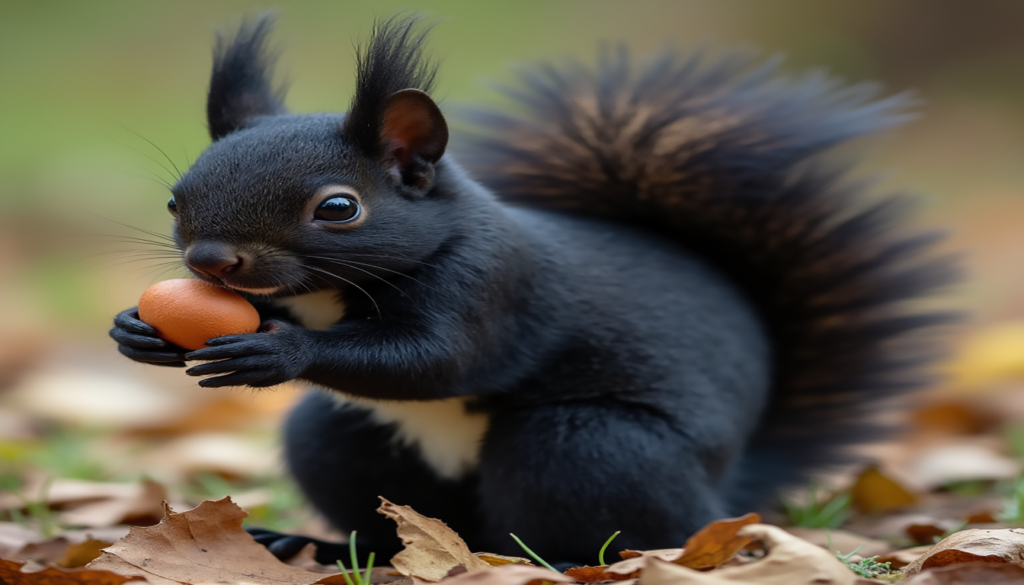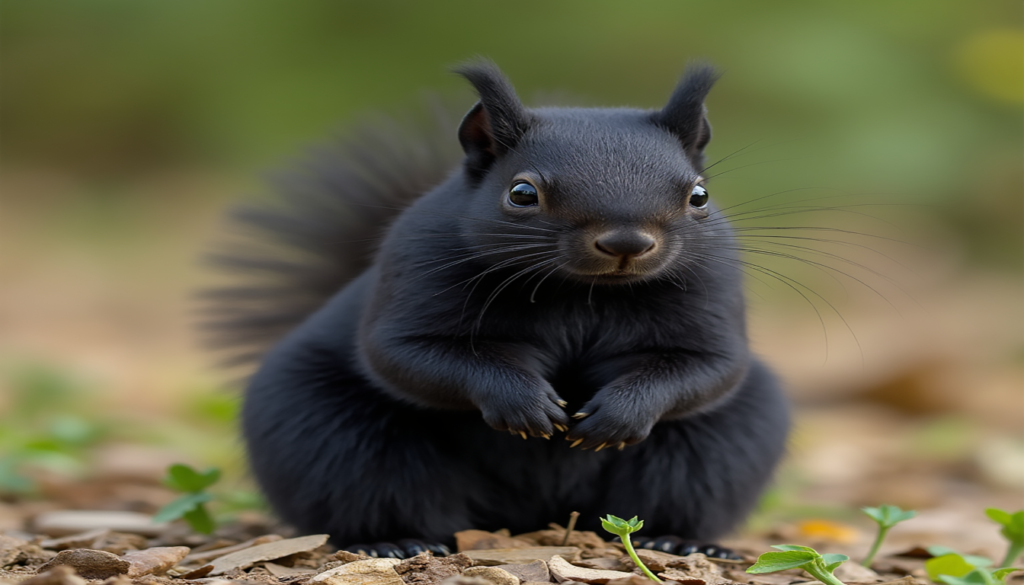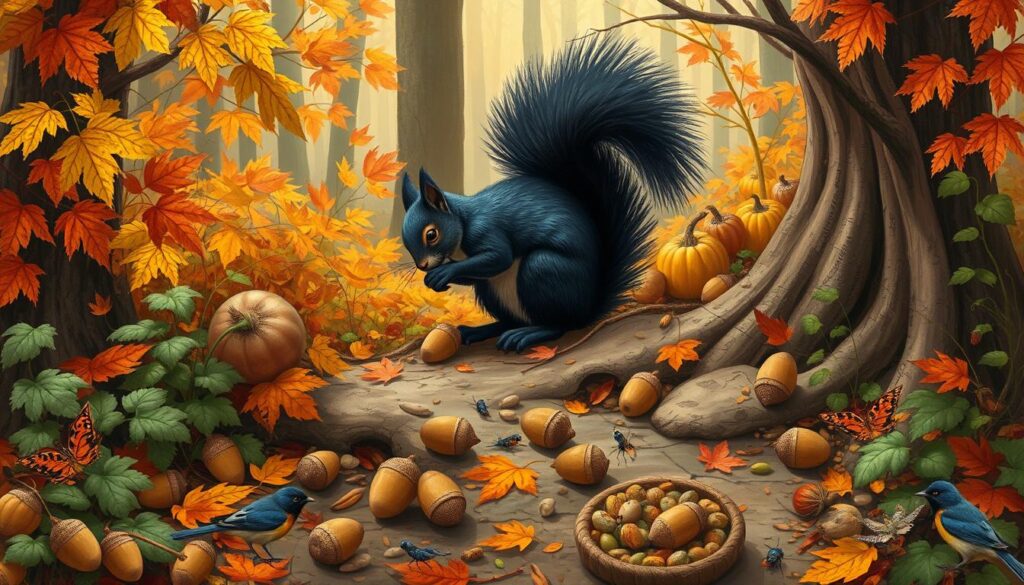
Ever wondered about the black squirrel you see in urban parks and forest edges? These squirrels are a special variation of the eastern gray squirrel. They have dark fur, thanks to a rare genetic mutation called melanism.
You might see black squirrels in certain areas of North America. Places like Ontario, Canada, and the Midwestern United States have them. Cities like Toronto, London, Washington, D.C., and parts of Michigan, Ohio, and Illinois also have these rare rodents.
Black squirrels are less common than gray ones. But they show us the amazing diversity in squirrels. Their genetic makeup makes them less common, making them a rare sight for those who love wildlife and city life.
Table of Contents
Understanding the Black Squirrel Phenomenon
Black squirrels are a mystery that fascinates many. They are rare, making up less than 1% of all squirrels. This makes them a unique part of the squirrel world.
What Makes Their Color Unique
Scientists say a genetic phenomenon called melanism is why some squirrels are black. This rare mutation gives them a dark color that stands out from gray squirrels.
Genetic Mutation and Melanism
Black squirrel genetics tell an interesting story of adaptation. A mutation in the MC1R gene leads to dark fur. This change happens mostly in eastern gray squirrels.
- Genetic mutation affects fur pigmentation
- Less than 1% of squirrels exhibit black coloration
- Mutation occurs in the MC1R gene
Relationship to Gray Squirrels
Black squirrels are actually a color variant of the eastern gray squirrel. Their black color helps them in cold weather and in hiding. This is because they can absorb more heat and blend in better.
| Characteristic | Black Squirrels | Gray Squirrels |
|---|---|---|
| Genetic Origin | MC1R Gene Mutation | Standard Pigmentation |
| Population Percentage | Less than 1% | Over 99% |
| Heat Absorption | Higher Efficiency | Standard |
“Black squirrels represent nature’s remarkable genetic diversity, showcasing how a single mutation can create a visually striking and potentially advantageous variation.” – Wildlife Geneticist
Physical Characteristics and Appearance
Black squirrels are a unique species that fascinate many. They weigh between 1 to 1.5 pounds and are about 9 to 10 inches long. Their tails can add up to an extra foot.
Their most notable feature is their rare black color. This comes from a genetic mutation that makes their fur dark. This color makes them stand out from gray and red squirrels, adding beauty to forests.
“Black squirrels are nature’s living proof that genetic diversity can create extraordinary beauty.” – Wildlife Researcher
Distinctive Physical Features
- Dense, jet-black fur covering entire body
- Bushy tail spanning up to 12 inches
- Bright, alert eyes contrasting with dark fur
- Muscular build typical of tree-dwelling rodents
Black squirrels are rare, making up less than 1% of squirrels. Their unique look comes from melanism, a condition that makes their fur dark.
| Physical Characteristic | Measurement |
|---|---|
| Average Body Weight | 1 – 1.5 pounds |
| Body Length | 9 – 10 inches |
| Tail Length | Up to 12 inches |
| Genetic Occurrence | 1 in 10,000 squirrels |
Their striking appearance is not just beautiful. It also helps them survive, especially in cold places. Their dark fur can keep them warmer.
Natural Habitat and Distribution Range
Black squirrels are fascinating creatures found across North America and beyond. Their habitat shows how they adapt and survive. While rare in some areas, they are a unique variation of eastern gray squirrels.
North American Population Centers
The Great Lakes region is a key habitat for black squirrels. Major population centers include:
- Ontario, Canada
- Michigan, United States
- Southern regions of New England
- Urban parks in major cities
European and Global Presence
Black squirrels are not just in North America. They are also found in the UK and parts of Europe. This shows their ability to adapt to different environments.
Preferred Environmental Conditions
Black squirrels prefer certain environments to survive. Their favorite places include:
- Dense woodland areas
- Urban parks with mature trees
- Regions with cold climates
- Environments with minimal predator pressure
“Black squirrels represent nature’s ingenious adaptation to environmental challenges.” – Wildlife Ecologist
| Region | Black Squirrel Prevalence | Key Characteristics |
|---|---|---|
| Great Lakes Basin | High | Cold-climate adaptation |
| Ontario, Canada | Very High | Significant urban populations |
| Michigan, USA | High | Diverse habitat ranges |
| United Kingdom | Moderate | Introduced populations |
Their dark fur helps them stay warm in cold weather. This shows how nature adapts and survives in different ways.
Black Squirrel Behavior and Lifestyle
Black squirrel behavior is full of adaptability and survival tricks. They share traits with gray squirrels but have their own special ways. Black squirrels are mostly active during the day, moving easily in cities and nature.

They spend their days trying to survive and socialize. Black squirrel behavior includes:
- Extensive foraging for diverse food sources
- Intricate nut and seed collection strategies
- Sophisticated nest-building techniques
- Complex social interactions within their communities
Studies have found some interesting facts about black squirrels. Interestingly, one study found that black squirrels were less likely to flee from predator sounds compared to gray squirrels. Their genetic differences might affect how they react to threats.
“Black squirrels demonstrate remarkable adaptability in both urban and natural settings” – Wildlife Research Journal
Black squirrels are consistent in their foraging. They gather a wide range of food, including:
- Wild fruits and berries
- Tree bark and buds
- Mushrooms
- Insects
- Occasionally, human-related food sources
They stay active all year, unlike hibernating animals like chipmunks. Black squirrels keep up their survival tactics even in harsh winters. This shows their incredible resilience and adaptability.
Survival Advantages of Black Fur
Black squirrels have special traits that make them different from gray ones. They have evolved to survive better in many places. This is because of their unique black fur.
Heat Absorption Benefits
In cold places, black squirrels have an advantage. Their dark fur catches 20%-30% more heat from the sun. This helps keep them warm in winter when gray squirrels might get cold.
Predator Evasion Tactics
Black squirrels’ dark fur helps them hide well in forests, especially when it’s dark. They are also more aggressive than gray squirrels. This makes them better at surviving.
Seasonal Adaptations
Black squirrels can live well in many places. They have a high survival rate, from 60%-80% in different areas.
- Excellent heat absorption in cold regions
- Superior camouflage capabilities
- Higher aggression levels for resource competition
- Genetic flexibility for interbreeding
“Black squirrels represent a fascinating example of nature’s adaptive strategies.” – Wildlife Biologist
| Characteristic | Black Squirrels | Gray Squirrels |
|---|---|---|
| Heat Absorption | 20-30% more efficient | Standard absorption |
| Aggression Level | Higher | Standard |
| Survival Rate | 60-80% | 50-70% |
The comparison between black and gray squirrels shows how nature adapts. It highlights the amazing diversity and survival tactics in the animal world.
Diet and Foraging Habits
Black squirrel facts show a world of dietary adaptability. These creatures have developed smart foraging strategies. They survive in different environments with a diverse diet.
Black squirrels change their eating habits with the seasons. This helps them get the most nutrition and survive. Here’s how they eat differently at different times:
- Spring: Tender plant buds and fungi
- Summer: Fresh fruits and insects
- Autumn: Intense nut gathering and seed collection
- Winter: Relying on stored food caches
Black squirrels eat a wide variety of foods. Their diet includes:
| Food Category | Specific Items | Frequency |
|---|---|---|
| Nuts | Acorns, Walnuts, Sunflower Seeds | High |
| Fruits | Berries, Apples | Moderate |
| Protein Sources | Insects, Bird Eggs | Low |
Their caching behavior is amazing. Black squirrels store food in many places. They use underground and tree-based systems. This way, they have food when it’s scarce in winter.
“Black squirrels are nature’s ultimate survival experts, transforming foraging into an art of ecological adaptation.” – Wildlife Researcher
These adaptable creatures can even eat human food scraps in cities. This shows their flexibility in finding food.
Reproduction and Life Cycle
Black squirrels have interesting ways of reproducing. This helps them live in different places. Knowing about their life cycle shows how they can do well in many environments.
Breeding Seasons
Black squirrels breed twice a year. They do this in late winter and mid-summer. This lets females have more chances to have babies. Males compete to win the right to mate.
Nesting Behavior
Female black squirrels are great at building nests. They use leaves, twigs, and soft stuff to make dreys. These nests are in trees or hollow trunks. They keep the babies safe from harm.
Kit Development Stages
The growth of black squirrel kits is well planned:
- Birth: Newborns weigh about 0.5 to 0.65 ounces
- First 2 months: They rely fully on their mom
- 2 months: They start to eat on their own
- 9 months: They are ready to have babies
| Life Stage | Duration | Key Characteristics |
|---|---|---|
| Newborn | 0-2 weeks | Blind, hairless, completely dependent |
| Infant | 2-8 weeks | Developing fur, opening eyes |
| Juvenile | 2-9 months | Learning survival skills |
| Mature Adult | 9-15 months | Fully independent, reproductive capabilities |
“Black squirrels represent nature’s remarkable adaptation, showcasing resilience through their intricate reproductive strategies.” – Wildlife Biologist
These facts show how complex and interesting black squirrels are. They are amazing at surviving and growing in many places.
Role in Local Ecosystems

Black squirrels are vital to their ecosystems. They do more than just live in forests. In their habitats, they play important roles through different ecological functions.
One of their main jobs is seed dispersal. As a darker version of gray squirrels, they spread seeds around. This helps forests grow and keeps biodiversity high. They act like underground gardeners, planting seeds for new trees.
“Black squirrels are nature’s gardeners, unconsciously planting future forests with every cached seed” – Wildlife Ecologist
- Seed dispersal for tree species like oak and maple
- Supporting forest regeneration processes
- Creating microhabitat opportunities for other species
Black squirrels are also part of the food chain. They are food for birds of prey like hawks. Their numbers help keep the balance between predators and prey.
Their eating habits also help control insects. They eat many insects, which keeps pest numbers down. This shows how important they are to the ecosystem.
Learning about black squirrel habitats and roles is fascinating. It shows how nature’s systems are connected. These animals continue to amaze scientists with their contributions to the environment.
Conservation Status and Population Trends
Black squirrels play a special role in wildlife conservation. They are not a separate species but face unique challenges. Are black squirrels rare? Yes, their color comes from a rare genetic mutation in about 1 in 10,000 eastern gray squirrels.
Their habitat varies by region, with some places having more black squirrels. For example, Kent County, Michigan, has about 20% black squirrels. Urban areas like Toronto, Ontario, and Detroit, Michigan, also have large black squirrel populations.
- Toronto, Ontario: Over 10,000 black squirrels
- Detroit, Michigan: Around 3,000 black squirrels
- Kent County, UK: 10,000-15,000 black squirrels
Urban areas offer both benefits and challenges for black squirrels. Habitat fragmentation and deforestation hurt their survival. About 70% of eastern North America’s mature forests have been lost, disrupting their habitats.
“Urban adaptation might be the key to black squirrel survival in changing landscapes.” – Wildlife Conservationist
Climate change and human activities also threaten them. Road accidents and weather changes harm their numbers. Efforts are underway to protect urban green spaces and maintain ecological corridors for these unique animals.
Conclusion
Black squirrels are a fascinating genetic phenomenon that challenges our understanding of wildlife diversity. They are a unique variant of squirrels, emerging from a rare genetic mutation in gray and fox squirrel populations. Their striking black fur shows the intricate genetic patterns in nature.
What is a black squirrel? They are not a separate species but rather color morphs of eastern gray squirrels with a genetic twist. They can be found in North American campuses and urban landscapes, showing their adaptability. Research shows they share similar behaviors with their gray counterparts, proving fur color doesn’t affect their survival strategies.
Understanding black squirrels means appreciating their complex genetic background. The mutation that gives them their distinctive coloration shows the sophisticated mechanisms of natural variation. Their ability to thrive in diverse environments, from university campuses to urban gardens, highlights their resilience and genetic flexibility.
As researchers continue studying these intriguing creatures, black squirrels remain a testament to nature’s capacity for surprising genetic expressions. Their ongoing presence in ecosystems serves as a reminder of the rich biodiversity surrounding us. It invites further exploration and appreciation of wildlife’s subtle yet profound variations.
FAQ
What exactly is a black squirrel?
A black squirrel isn’t a different species. It’s a color variation of the eastern gray squirrel. This variation comes from a genetic mutation that makes their fur black instead of gray.
Are black squirrels rare?
Black squirrels are not very common. They make up about 1 in 10,000 squirrels. You can find them more often in certain areas of North America, like parts of Ohio, Michigan, and Ontario, Canada.
Why do some squirrels turn black?
The black color comes from a genetic mutation in the MC1R gene. This mutation helps them absorb heat better in cold climates. It also helps them blend in better in dark or dense forests.
Can black squirrels breed with gray squirrels?
Yes, black squirrels can breed with gray squirrels. They are the same species, with the black color being a genetic variation. Their babies can have black, gray, or mixed fur.
Where are black squirrels most commonly found?
Black squirrels are most common in North America. You can find them in parts of Ohio, Michigan, Ontario, and some cities like Kent, Ohio, and Toronto. They also live in some European places, especially in the UK.
Do black squirrels behave differently from gray squirrels?
No, black squirrels act the same as gray squirrels. They forage, interact, and survive in the same ways. The only difference is their fur color, which might give them a slight edge in their environment.
Are black squirrels considered a threat to local ecosystems?
No, black squirrels are not a threat. They help ecosystems by spreading seeds and supporting forest growth. They are as beneficial as gray squirrels in their environments.
Can black squirrels survive in urban environments?
Yes, black squirrels can do well in cities. They live in parks, college campuses, and neighborhoods. They show they can live with humans while still acting naturally.

